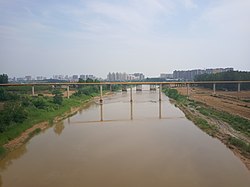Top Qs
Timeline
Chat
Perspective
Jing River
River in Gansu and Shaanxi, China From Wikipedia, the free encyclopedia
Remove ads
The Jing River (simplified Chinese: 泾河; traditional Chinese: 涇河) or Jing He (Pinyin: Jīng Hé), also called Jing Shui (simplified Chinese: 泾水; traditional Chinese: 涇水), is a tributary of the Wei River (Chinese: 渭河), which in turn is the largest tributary of the Yellow River.
This article needs additional citations for verification. (May 2021) |
The Jing River flows for 455.1 kilometres (282.8 mi), with a basin area of 45,421 square kilometres (17,537 mi2).[1] The river's flow varies greatly throughout the year, and soil erosion causes serious problems in its basin. Summer floods cause the Jing to be laden with sediment; in the dry season, the river flows with relatively clear water.
The river flows through important farming areas, and its basin is inhabited by 9.5 million people.[1]
Water in the Jing River comes from Mount Liupan in Ningxia Hui Autonomous Region and flows through Gansu and Shaanxi, where it joins the Wei River in Gaoling District of Xi'an.[1] Other than its upper reaches, the river flows through loess landscape throughout its length.[2]
According to Chinese mythology a Dragon King ruled over the river. The Jing River basin is one of birthplaces of ancient Chinese civilization such as the Zhou dynasty.[3][4]
Remove ads
Tributaries
Major tributaries of the Jing include the Malian, Pu, and Hong.[5]
See also
References
Wikiwand - on
Seamless Wikipedia browsing. On steroids.
Remove ads


